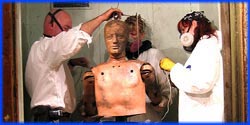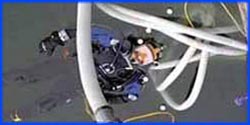


Premier Date: October 14, 2012
plausible
This myth supposedly arose from the German army’s careful construction of its trenches during World War I. Adam and Jamie started by building small-scale trenches filled with water and colored oil to help visualize wave movement. Three trenches were built: one straight, one with two sharp corners, and one with two soft (curvy) corners. A motorized mechanism generated waves at one end of each trench and the amplitude of the waves was measured at the opposite end. The amplitude for the straight trench was 0.75 inches (19 mm), for the sharp cornered trench it was 0.125 inches (3 mm), and for the soft-cornered trench it was 0.25 inches (6 mm), lending credibility to the premise.
For full scale testing, three 50 foot (15 m) trenches were dug in the same shapes and lined with plywood to ensure straight edges (the soft corners were not lined). A 25 lbs (11 kg) charge of TNT was used for each explosion and force sensors were placed at 10 foot (3 m) increments from the charge. The following table summarizes the findings.
| Trench Shape | Pressure at 20 ft | Pressure at 30 ft | Pressure at 40 ft | Pressure at 50 ft |
|---|---|---|---|---|
| Open-air (control) | 39 psi (269 kPa) | 12 psi (83 kPa) | 7 psi (48 kPa) | 5 psi (34 kPa) |
| Straight | 397 psi (2737 kPa) | 65 psi (448 kPa) | 38 psi (262 kPa) | 21 psi (145 kPa) |
| Sharp corners | 60 psi (414 kPa) | 19 psi (131 kPa) | 12 psi (83 kPa) | 7 psi (48 kPa) |
| Soft corners | 76 psi (524 kPa) | 21 psi (145 kPa) | 13 psi (90 kPa) | 8 psi (55 kPa) |
Because the intensity of the blast was lower with sharp corners than with soft corners or no corners, the myth was deemed plausible.
busted
In order to simulate a car crash at 35 mph (56 km/h), the Build Team dropped cars onto their front bumpers from a height of 41 feet (12.5 m). A dummy with force sensors was placed in the passenger seat for each drop. A control crash with no seat belt and no balloons gave a maximum force to the dummy’s chest of 640 g, which was well above the 100 g benchmark for lethality. A drop with normal latex balloons in front of the passenger gave a maximum force of 620 g, so they had little effect. Back in the workshop, the team experimented with different types and configurations of balloons including small balloons, large balloons, balloon animals, and giant, extra-thick balloons. The giant, extra thick balloons performed the best at cushioning an impact so the Built Team packed the car tightly with those balloons for another drop that resulted in a maximum force of 130 g (still lethal). For a final test, they tried taping many small balloons to plastic sheets in order to prevent movement and to prevent holes forming from only a few popped balloons. With this test the maximum force was 230 g, definitively busting this myth.
Previous: Episode 190: Titanic Survival
Next: Episode 192: Hail Hijinx